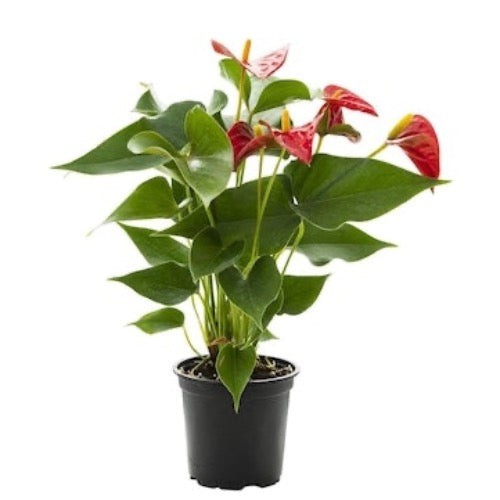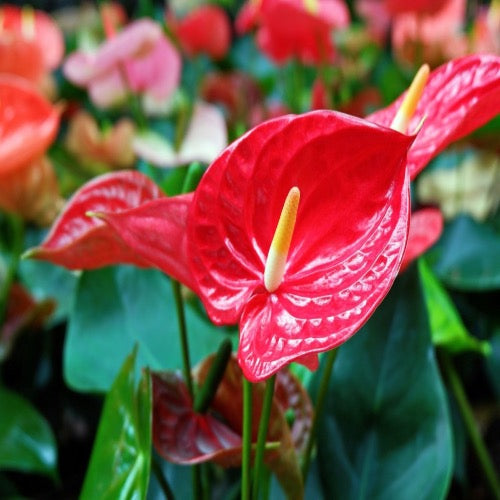
Plant It Tampa Bay
Anthurium Red Flowering
Couldn't load pickup availability
Overview
Anthurium Red Flowering
Tropical-looking flowers and waxy heart-shaped leaves are the hallmarks of Anthurium. These easy-care houseplants can bloom for months at a time, providing a welcome burst of color. If the basic conditions are right, the Anthurium generally prefers to be left alone, making it a very easy plant to care for and enjoy.
- Plant in groups to create a lush, tropical feel to the landscape
- Bees and butterflies are attracted to the bold flower clusters
- Grows 12 in. W and tall to 18 in. W and tall
- Thrives in full sun to part shade and grows in almost any well-drained soil
* Important! Anthurium are poisonous if ingested, so be very careful if you have pets and/or small children.
 |
Advantages:
|
 |
Grows Best:Landscape Container Plant House Plant |
 |
Ideal position:Full Sun 6 + Hours best |
|
|
Growth Outlook:2 - 3 ' Tall 2 - 3 ' Wide Growth Rate: medium growers Plant Spacing: 12" - 18" |
 |
Pet Friendly - No
|
Description
Anthurium Red Flowering
The Anthurium plant, also known as the Flamingo Flower or Painter's Palette, is a stunning tropical plant that adds a touch of elegance to any indoor space. With its glossy, heart-shaped leaves and vibrant, waxy flowers, the Anthurium is a true showstopper.
The flowers of the Anthurium come in a variety of colors, including shades of red, pink, white, and even green. These unique flowers are characterized by their spiky, protruding spadix, which is surrounded by a colorful, heart-shaped spathe. The combination of the spadix and spathe creates a striking and eye-catching display.
Caring for an Anthurium plant involves providing it with bright, indirect light, as direct sunlight can scorch its leaves. It thrives in well-draining soil and requires regular watering, allowing the top inch of soil to dry out between waterings. Maintaining a warm and humid environment is also beneficial for its growth.
Fertilizing the Anthurium plant every two to four weeks during the growing season with a balanced, water-soluble fertilizer can help promote healthy foliage and continuous flowering. Pruning any yellow or damaged leaves will keep the plant looking tidy and encourage new growth.
Anthurium plants are popular choices for indoor gardens, offices, and as decorative accents due to their long-lasting blooms and attractive foliage. They also make excellent gifts for plant enthusiasts or as a symbol of love and admiration.
With its exotic appearance and easy care requirements, the Anthurium plant is a captivating addition to any plant collection, bringing a touch of tropical beauty and elegance to any space.
Caring For
 |
 |
 |
 |
| Ideal position | Water | Temperatures | Food |
Caring for an Anthurium plant involves several key steps to ensure its health and vibrant blooms:
1. Light: Anthurium plants thrive in bright, indirect light. Avoid placing them in direct sunlight, as it can scorch their leaves. A north or east-facing window is ideal, or provide filtered light if necessary.
2. Temperature and Humidity: Anthuriums prefer temperatures between 65-80°F (18-27°C). They also appreciate high humidity levels, so misting the leaves regularly or placing the plant on a tray filled with water and pebbles can help create a humid environment.
3. Watering: Water your Anthurium plant thoroughly when the top inch of soil feels dry. Avoid overwatering, as it can lead to root rot. Ensure proper drainage and never let the plant sit in standing water.
4. Soil: Anthuriums prefer a well-draining soil mix. A combination of peat moss, perlite, and orchid bark works well. Avoid heavy soils that retain too much moisture.
5. Fertilizing: Feed your Anthurium plant with a balanced, water-soluble fertilizer every two to four weeks during the growing season (spring and summer). Follow the package instructions for proper dilution and application rates.
6. Pruning: Remove any yellow or damaged leaves promptly to maintain the plant's appearance and overall health. Trim back any leggy or overgrown stems to encourage bushier growth.
7. Pests and Diseases: Anthurium plants are generally resistant to pests, but occasionally they may encounter issues with aphids, mealybugs, or spider mites. Treat any infestations promptly with insecticidal soap or neem oil.
8. Repotting: Anthuriums prefer slightly crowded roots, so repotting is typically only necessary every two to three years. Use a slightly larger pot with fresh, well-draining soil when repotting.
By following these care guidelines, you can ensure that your Anthurium plant remains healthy, lush, and produces vibrant blooms. Remember to provide the right light conditions, maintain proper watering and humidity levels, and fertilize regularly to promote optimal growth and flowering.
Landscape uses:
- Accent in a mixed bed
- Filler plant for a garden corner
- Along a deck or patio
- In a pool cage planter (in an area that won't get splashed)
- Between palm trunks
- Entryway accent
- Large, full plant for the corner of the house
- Under tall trees
- Container plant
Plant spacing
Plant 3 or 4 feet apart. Come out from the house 3 feet.
Share








